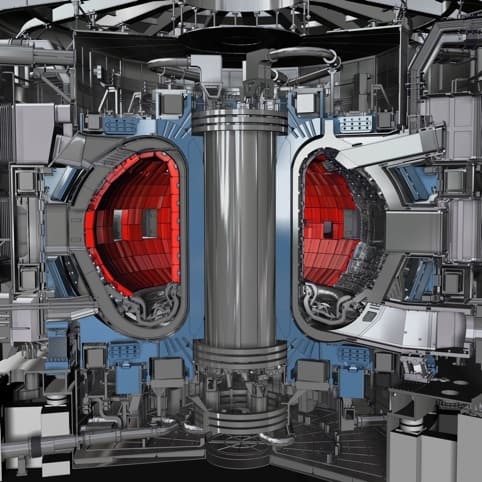Last week found me in Cadarache, near Marseille in southern France along with some 50 other journalists, visiting the site of what will be the world’s largest nuclear fusion experiment: the magnetic confinement system known as ITER. The acronym originally stood for International Thermonuclear Experimental Reactor but which is now referred to as meaning ‘The Way’ in Latin in a slightly woolly fashion.
After many years being as woolly a concept as any high-tech project could be, ITER is now beginning to take literal concrete form. There’s not a great deal to see on the site itself. To be blunt, it’s a hole in the ground, blasted out of the limestone bedrock and being readied for the foundations of the tokomak — the doughnut-shaped fusion reactor vessel and the many ancilliary systems needed to contain the plasma of deuterium and tritium that forms the raw material of fusion and coax it into the conditions needed to force the nuclei to fuse together.
But around the world, in the 35 countries which make up the ITER members (the EU states, India, China, Russia, Korea, the US and Japan), the components of the machine are starting to take shape. And it’s only now becoming clear how the biggest challenge of the project probably doesn’t lie in plasma physics, in magnet design, in materials science, in control engineering or even in mechanical or civil engineering; it’s an issue of project management and quality control.

Such is the labyrinthine complexity of ITER’s organisation that it’s not just separate systems and subsystems which are coming from different nations; it’s various components of individual systems. For example, the superconducting cables that will form the magnets are being made in four countries. The vacuum vessel itself is being manufactured in nine sections, seven of which are being made in Europe and two on the other side of the world in Korea. And although common quality standards must be reached by all the manufacturers, they can use whatever manufacturing techniques they want to make their components.
It’ll be up to assembly team on site to make sure all these pieces fit, checking the materials and carrying out any machining necessary to bring this enormous 3D jigsaw puzzle together. And, of course, that’s if everything arrives on time, and indications for that so far aren’t good; the enormous hangar-like building where the all but one of the poloidal magnets, which will wrap around the outer circumference of the vacuum vessel, is entirely empty, awaiting the arrival of tooling which hasn’t turned up yet.
It’s in the nature of enormous international projects to be late and over-budget. When the schedule and budget for ITER were first drawn up, a great deal of the project was still conceptual — it hadn’t even been decided what the magnets would be made of or how the inside of the reactor, which will have to cope with temperatures hotter than the sun, would be designed. But it seems likely even at this stage that schedules would slip. ITER director-general Osamu Motojima indicated that the complexity of integrating the components could delay ITER’s first deuterium-only plasma by another two years — originally slated for 2018, it’s now not expected until 2020, but Motojima said it might not happen until 2022 or even 2023. However, he added, this would not necessarily delay the first deuterium-tritium experiments, where the reactor would begin to perform fusion; research at the current-largest tokomak in the world, JET in Culham, UK, and the Tore Supra tokomak near the ITER site would generate enough data on plasma management to allow ITER’s operators to omit some of the experiments originally scheduled on the machine: fusion should still begin by 2028, Motojima said.
This will be elucidated further next year at ITER’s next council meeting, when what Motojima referred to as a ‘realistic schedule’ for the construction phase will be decided and published. By that time, many components should already be on-site in France and the tokomak building, along with several other buildings on site, should be well out of the ground. But schedule slips and budgetary concerns will be awkward for Motojima; the director-general could come under pressure, creating uncertainty in the multinational organisation.
It’s heartening to see the project finally moving into a construction phase; after so long as a concept, ITER is becoming real. But this is a critical phase. As manufacturing gathers pace, it’ll become clearer exactly what it’ll take to turn this disparate collection of components into a working machine; and that’ll help us work out how practical fusion is as a commercial source of energy.
And that’ll lead us to another concern. Everyone during the visit pointed out how complex the ITER machine is, while also claiming that fusion is a ‘potential clean energy source for the whole world.’ But could that very complexity act as a barrier to its take-up? It’ll be many years until we know: on current reckoning, not until well into the 2040s, when ITER’s successor, the proposed prototype fusion power station DEMO, is up and running. But DEMO’s construction depends on ITER working, and it’s unlikely it could be built by an international collaboration because it will only supply electricity to one national grid. Yet another layer of complexity for a project which is already far from simple.




Project to investigate hybrid approach to titanium manufacturing
What is this a hybrid of? Superplastic forming tends to be performed slowly as otherwise the behaviour is the hot creep that typifies hot...